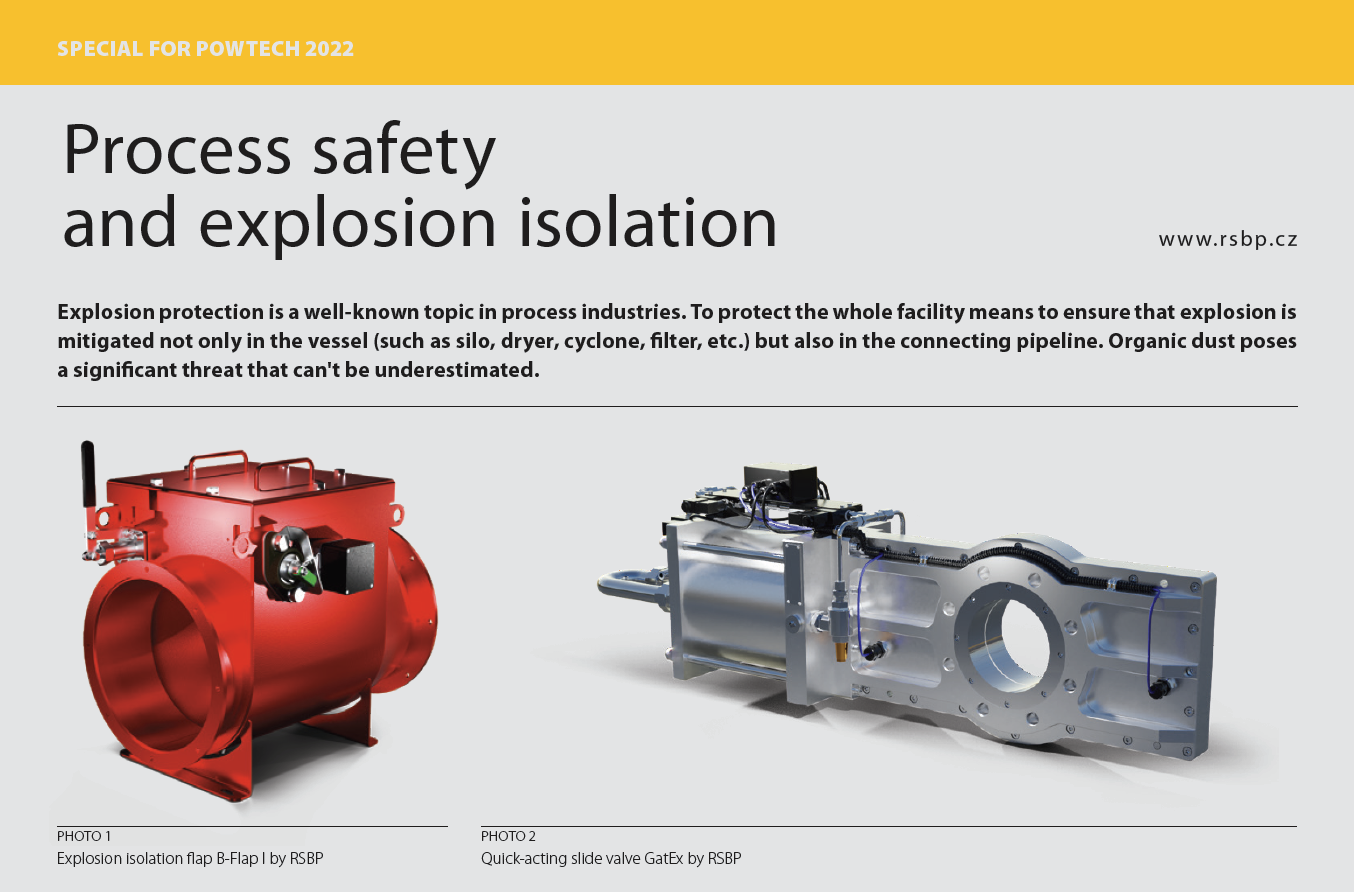Diese Website verwendet Cookies, um die Qualität der Dienstleistungen zu verbessern und das Angebot für unsere Kunden in Übereinstimmung mit den Datenschutzrichtlinien zu personalisieren. Sie können Ihre Cookies-Einstellungen anpassen. Schließen
This time we focused on the principles and advantages of explosion isolation. As a supplement type of protection to explosion venting and explosion suppression. Read about the benefits below:
Explosion protection is a well-known topic in process industries. To protect the whole facility means to ensure that explosion is mitigated not only in the vessel (such as silo, dryer, cyclone, filter, etc.) but also in the connecting pipeline. Organic dust poses a significant threat that can't be underestimated.
There are many ways how you can protect your production process. When it comes to the technological equipment of the facility, you may have encountered explosion venting panels or flameless explosion devices. If venting is not suitable for production, an alternative comes in the form of explosion suppression. Each type of explosion protection is suitable for different production processes. Nowadays, it is technologically possible to identify all imminent risks in advance. The obligation to apply appropriate preventive measures is imposed by the ATEX 153 directive, which achieves the protection of human lives and production technology from the devastating consequences of an explosion. It is essential to consult an expert in the explosion protection market to see which solution is best for your production process.

To ensure maximum employee safety and minimal damage to technological equipment, explosion protection devices must also be installed onto the connecting pipelines. Two main ways to isolate an explosion are passive and active. Passive explosion isolation valves close by the pressure wave from the explosion. These solutions function without detection or control units. Active explosion isolation valves are controlled by an explosion detector (pressure or optical), which continually monitors conditions and in the event of explosion triggers the valves to isolate an explosion.
Flap valves are most commonly used when it comes to mechanical isolation. The explosion isolation flap valve offers customers effective prevention of explosion transmission between connected technologies. The explosion isolation flap isolates the explosion in the entire pipeline of the suction systems. Thus it is suitable not only to prevent the transmission of explosions at the inlet to the filter or cyclone but also to isolate the explosion on the outlet piping from filtration systems (clean side of the filter). Other installation options are, for example, on the suction line to the mill or the inlet, where material flows to dryers and other similar equipment. During regular operation, the explosion isolation flap valve is kept open. During the explosion, the pressure wave from a blast closes the flap valve and locks it into a "closed" position. Explosion isolation flap valves can be certified according to EN 16447 or EN 15089.
The quick-acting slide valve is usually part of a system used to prevent the propagation of an explosion between the individual units of the production technology. The quick-acting slide valve is activated when an explosion is detected. Pressure and optical detectors constantly monitor the protected zones of the production technology. Activation of the quick-acting slide valve is also possible via the explosion venting devices. The detector sends a signal to the control unit, which activates the closing mechanism. The quick-acting slide valve is closed pneumatically. When an explosion occurs, the pipe will be completely closed in milliseconds. The quick-acting slide valve is suitable for facilities using pneumatic conveying, extraction, and in places requiring a short installation distance. One of its main advantages is its design for maximum explosion pressure (pmax). The fail-safe feature on the quick-acting slide valve puts the slide in a safe state (closed) in case of a power cut or a pressure drop in the protected technology. The device is certified according to EN 15089.
The HRD Barrier is an active system that prevents the transmission of an explosion. It releases the extinguishing agent extremely fast into the pipeline and thus stops the rapid increase in pressure. Detection is necessary for HRD Barrier to work. Similar to quick-acting slide valve pressure, optical detectors constantly monitor the protected zones of the production technology. If an explosion is detected, the detectors transmit a signal to the control unit, which activates the HRD container units. These are equipped with quick-opening valves capable of immediately releasing the extinguishing agent into the protected space, thus creating an effective extinguishing barrier. Activation of the HRD Barrier is also possible via the explosion venting device. The HRD Barrier suitably complements the HRD explosion suppression system used to protect technological equipment. The appropriate combination of these two systems efficiently prevents property damage and protects human lives. This explosion isolation system is certified according to EN 15089 standard.
Risk of explosion expansion is present mainly during the transportation of bulk material in pipelines that connects individual parts of the production technology. Initiation (e.g., hot surface, friction, a spark from equipment failure, etc.) can be easily formed, which in combination with flowing air and transported material creates a highly explosive mixture. During an explosion, a pressure wave first blasts through the pipe, followed by a flame. When transferred to subsequent parts of the production technology, secondary explosions may occur, which can have even more devastating consequences due to the turbulence created in the piping system. Improperly designed fire and explosion protection elements can increase the existing risk of an explosion. Do not put yourself unnecessarily at risk and work only with qualified specialists.